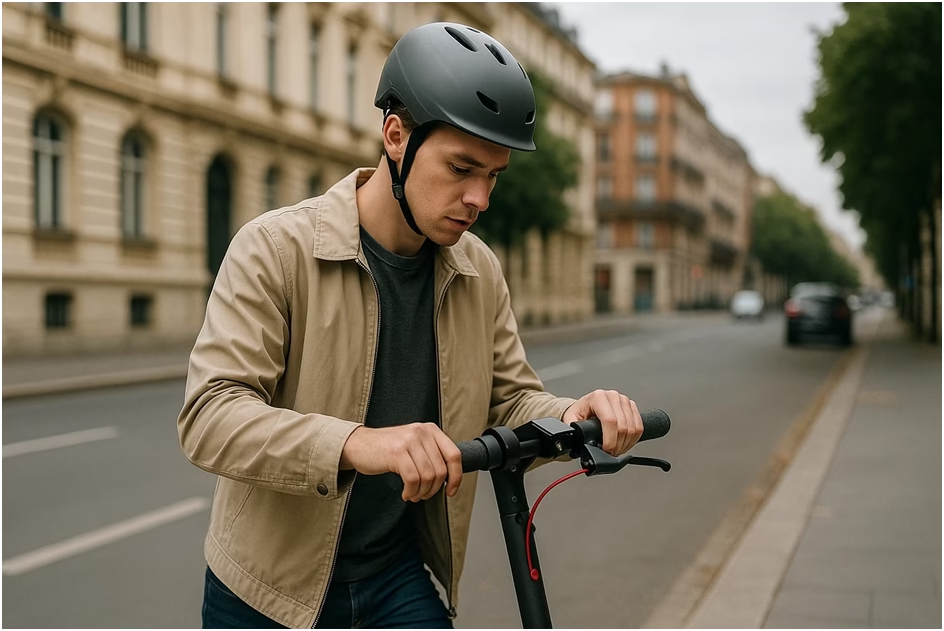Buying a first electric scooter feels exciting. You picture smooth rides, less time in traffic, and a bit of fun on the way to work or school. Then real life starts. Rough roads. Shorter range than the box promised. Squeaky brakes. Loose bolts. Wet mornings.
Most problems do not come from bad scooters. They come from rushed choices and small daily habits that slowly wear the scooter and raise the risk of falls. This guide walks through ten mistakes I made, saw in friends, or read in real rider stories. You can skip a lot of pain if you avoid them from day one.
You will see simple, direct tips. No jargon. No tricks. Just clear steps that keep you safe, protect your money, and help your scooter last longer.
Mistake 1: Buying the Wrong Scooter for Your Real Life
Many new riders choose a scooter only from specs on a page. Top speed looks high. Range looks long. Price looks fair. That feels enough. It is not.
Range ratings often refer to a light rider on flat roads at low speed. Real life includes hills, stops, cold days, and extra weight from a backpack or groceries. A scooter that claims 40 km may give you 20–25 km in daily use. That gap matters if you plan a return trip.
Think about your real route.
- Daily distance.
- Hills or bridges.
- Road type.
- How often you need to fold and carry the scooter.
If you climb hills each day, focus on motor power and torque, not only top speed. If you live in a walk-up flat, look at weight first. If you ride in crowded streets, short wheelbase and narrow bars can feel twitchy. A more stable deck and wider handlebars often feel better for a new rider.
Try to see the scooter in person. Step on the deck. Grab the bars. Lift it by the stem. If any of these feel wrong, that model will not improve later.
Mistake 2: Skipping Safety Gear
Many beginners think a scooter is “just like a bike but smaller”. Some ride in city traffic with no helmet, no gloves, and no lights. That choice often changes after the first fall.
Scooters have small wheels. A small pothole or loose stone can stop the front wheel fast. Your body keeps moving. Even at 20 km/h, a fall on asphalt can bring cuts, broken teeth, or worse. A basic bike helmet reduces the risk of a serious head injury. This is not drama. It is simple physics.
Start with three items.
- Helmet with proper fit and a strong strap.
- Gloves with palm protection.
- Front and rear lights that car drivers can see.
Add knee and elbow pads if you ride faster or at night. Bright or reflective clothing helps drivers see you from a distance. A simple reflective vest weighs almost nothing in a backpack yet can save your life in dark rain.
Think of safety gear as part of the scooter, not an extra. You do not ride without wheels. Treat the helmet the same way.
Mistake 3: Trusting the Advertised Range
Most scooter ads show a big range number. Many riders feel upset when they get half of that in daily use. The brand did not lie. The test simply used perfect conditions.
Range depends on:
- Rider weight.
- Speed and ride mode.
- Temperature.
- Hills and stops.
- Tire type and pressure.
If you ride near top speed, range drops fast. Cold weather reduces battery output as well. Low tire pressure adds rolling resistance, so the motor needs more power for the same speed.
Plan with a safety margin. Take the claimed range and cut it by 30–50%. Use that number for your route plan. If the scooter still covers your daily need with room to spare, good. If not, you need a larger battery or a charging option at work.
Try to keep regular charging habits. Do not ride until the battery goes flat each time. Deep empty cycles stress the cells. Keep the battery level between about 20% and 80% most days. Charge to 100% before long trips, then ride soon. Long storage at full charge shortens battery life.
Mistake 4: Underestimating Braking Distance
New riders love speed. They rarely think about how long the scooter needs to stop on wet asphalt or loose gravel. Short decks and narrow tires make panic stops harder to control.
Practice braking in a safe empty space. Start at walking speed. Then increase to 10 km/h, 15 km/h, 20 km/h. Use both brakes if you have front and rear. Lean your body slightly back when you brake. This shifts weight away from the front wheel, lowers the risk of a front flip, and adds grip to the rear tire.
Check what type of brakes you have.
- Mechanical or hydraulic disc brakes offer strong stopping power.
- Drum brakes need less care but can feel weaker.
- Electronic brakes alone are not enough for emergency stops.
Keep brake parts in good shape. Look at the pads. If they look thin, replace them. If the lever feels soft, adjust the cable or bleed the hydraulic system. A small squeak may warn you early. Do not wait until the lever hits the handlebar with little effect.
Safe braking is a skill. You build it with practice, not in the first panic moment in traffic.
Mistake 5: Ignoring Tire Pressure and Wheel Care
Tires look simple. You inflate them once, then forget them. Many riders do this, then face flats, wobble, or poor grip in the rain.
Check tire pressure at least once per week. Use a simple hand gauge if the scooter valve is hard to reach. Follow the pressure range on the tire sidewall. Stay in the middle of that range for daily city use. Low pressure gives soft ride but more pinch flats and weaker range. Very high pressure feels harsh and can reduce grip on rough roads.
Watch the tread. Long rides on asphalt wear the center first. A bald spot in the middle reduces traction in wet turns. Change the tire when the tread looks flat and smooth.
Solid or honeycomb tires remove the risk of flats but pass more shock to your legs and knees. If your scooter uses these, still check for cuts, missing chunks, or cracks near the bead. Any damage in that area can lead to sudden failure.
Clean small stones stuck in the tread. They can work deeper with each ride and pierce the tube. A two minute check after weekend rides can prevent an hour by the roadside.
Mistake 6: Riding Only in the Fastest Mode
Most scooters offer several modes. Eco. Normal. Sport. Many beginners lock the scooter in the fastest mode from day one. Speed feels fun. Slow modes feel boring.
High power means sharp throttle response. Small hand movement gives a big jump in speed. In busy streets this makes fine control hard. Small bumps, wet lines, or sudden pedestrians ask for smooth inputs. Sport mode often does the opposite.
Start in the mildest mode for the first weeks. Learn how the scooter reacts when you:
- Start from a stop.
- Turn at low speed.
- Brake on a slope.
Then move to a higher mode on quiet roads. Switch back to eco mode in crowded areas. Think of speed as a tool, not the default. You gain nothing if you save two minutes but raise crash risk each day.
Some scooters allow custom acceleration in the app. Set a softer start and limit peak speed at first. You can raise it later when your reflexes match the machine.
Mistake 7: Bad Charging Habits
Charging looks simple. Plug the charger each night. Unplug in the morning. Many people leave the scooter at 100% for days. Some store it for weeks at low charge in a cold garage. Both shorten battery life.
Use a quality outlet in a dry room. Keep the charger on a hard surface, not on a bed or under clothes. The brick can warm up during fast charge. Free air around it keeps the temperature under control.
Follow three basic rules.
- Do not leave the scooter on charge for many days.
- Do not store it for months with almost empty battery.
- Avoid full charges right before long storage.
For long storage, set the battery near the middle of its range. Around 40–60%. Store the scooter in a cool, dry room, not in direct sun and not in freezing air. Check the level once each month and top it if it falls too low.
If the charger ever smells odd or shows visible damage, replace it. A cheap third party charger with no safety marks can damage the battery or worse.
Mistake 8: Forgetting Basic Maintenance
An electric scooter has fewer parts than a motorcycle. Still, it is not zero-care. New riders treat it like an old toy. Ride, leave in the hall, repeat. Screws slowly loosen. Fenders crack. Folding parts gain play. At some point, the deck starts to creak and the stem wobbles.
Set a simple routine.
- Quick check before each ride.
- Short clean and bolt check each weekend.
- Deeper check each month.
Before each ride, look at the tires, brakes, and folding latch. If a part looks wrong, do not ignore it. Mechanical problems do not heal on their own.
Once per week, wipe the deck and stem with a damp cloth. Dry the metal parts. Use a basic tool kit to check key bolts. Many brands publish a list of critical screws for this task.
For deeper monthly care, inspect cables, connectors, and frame welds. Look at the brake cables for fraying. Check the headlight bracket and rear light wires. Shake the folded scooter gently and watch for loose parts.
You do not need to be a mechanic. Simple checks catch problems early and keep you safe. For step by step instructions, see guides on Electric Scooters Guides.
Mistake 9: Riding in Bad Weather With No Plan
Most spec sheets show an IP rating. Many riders see this number and think the scooter behaves like a boat. It does not. Even models with water protection still have weak points. Connection covers crack. Rear mudguards spray water into the deck area. Standing water on the road hides deep holes.
Light rain on smooth asphalt already raises stopping distance. Painted lines, metal covers, and wet leaves turn into ice-like patches under small wheels. Try to avoid sharp turns and heavy braking on these surfaces.
If you must ride in rain, slow down. Use good lights front and rear. Wipe water from the deck and folding joint when you reach home. Open the rubber charge port cap and dry around it.
Never ride through deep puddles that reach the wheel hubs. Water can enter bearings and motor housings. The scooter may not stop at once, yet rust starts from inside.
If the brand manual clearly says “no rain use”, respect that rule. One wet ride can void warranty and put you at risk.
Mistake 10: No Practice Time and Weak Road Awareness
Many beginners step on the scooter for the first time right on a busy street. Cars on one side. Parked cars on the other side. Doors that may open. Pedestrians that step off the curb while staring at a phone. Stress rises at once.
First rides should take place in an empty parking lot or a quiet side street. Learn balance, steering, and braking in a place with no pressure. Use this time to test different stances on the deck. Many riders feel stable with one foot forward and one at an angle near the rear. Find what works for you.
Study local traffic rules for scooters. Some cities treat them like bikes. Others treat them as motor vehicles. Speed limits, bike lane rules, and helmet laws differ. Police do not accept “I did not know” as a reason.
Use clear hand signals when you turn. Do not ride in the blind spot of cars. Keep distance from parked cars so that an open door does not hit you. Avoid weaving between lanes. A predictable rider is easier for drivers to see and avoid.
Confidence grows with each safe ride. Rushing this stage leads to near misses or worse, then you fear the scooter instead of enjoying it.
Final Thoughts
Electric scooters are simple machines. Two wheels. A deck. A battery. A motor. Yet the mix of speed, small tires, and urban chaos gives them real power to help or to harm. The ten mistakes above look small on paper. In daily life they decide if your scooter journey feels smooth or full of stress.
Choose a scooter that fits your route and your body. Wear a helmet each time. Respect range limits. Keep brakes, tires, and bolts in good shape. Charge and store the battery with care. Practice in safe spaces, then ride in traffic with calm and clear rules in mind.
Do this and your scooter becomes a reliable part of your day, not a source of fear or broken parts.





